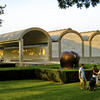More about Skeletons Warming Themselves
- All
- Info
- Shop

Contributor
James Ensor was a big fan of skeletons.
Skeletons Warming Themselves is only one of many paintings Ensor created which referenced creepy, haunting skeletons. Before the birth of his skeletons, Ensor was involved in the avant-garde circles. He was a serious theater geek. While studying art, Ensor was a frequent visitor of performance scenes: burlesque shows, café-concerts, music halls, you name it. A kaleidoscope of masked women, cancan dances, trapeze performances, and vaudeville acts enticed the artist. And who wouldn’t be intrigued by a non-stop circus of acts going on all around you? Ensor was a diligent student and would bring with him a notebook, which he’d fill up, page after page, with sketches of these elaborate, almost magical performances.
Ensor’s skeletons are both a farce and a meditation of morality. These rattling bad boys link to fumisme, a type of art form that would satirize cultural and social norms. Along with the masks and puppets and the seemingly harmless silhouettes, skeletons were seen in satirical performances as a tool to poke fun at regular society.
There’s definitely something absurd about Skeletons Warming Themselves, as of course skeletons have no flesh. Plus, notice how they are are outfitted. This is a couple dressed to the nines. Ensor is criticizing the bourgeoisie, more or less saying that they’re spiritually empty, and do things for no good reason.
Skeletons Warming Themselves is filled with treats to delight the eyes. A painter’s pallet and a musician’s violin lay beside the fire; artifacts of culture used as fuel for the flame. Written on the stove are the words, “The fire is out” and, “Will you find any tomorrow?” It’s likely that the tableaux seen in the painting really was installed in Ensor’s art studio. The costumes the skeletons in Skeletons Warming Themselves are owned by his family living above his Ostend studio.
Unfortunately, Ensor’s skeletons weren’t very popular. Fortunately, Ensor was a big believer in himself. Ensor was certain of his visions, despite contemporary critics and artists despising his work. His attitude was something like “I am a genius and you’re all fools. The kids of tomorrow will like me. You best believe it.” No bones about it...he was right.
Sources
- Susan M. Canning, “James Ensor: Carnival of the Modern,” James Ensor, ed. Anna Swinbourne, New York: The Museum of Modern Art, 2009.
- Susan M. Canning, “Of Puppets and Pierrots, Skeletons and Masks: James Ensor’s Symbolist Staging of Modernity,” The Symbolist Roots of Modern Art, ed. Michelle Facos, Thord J.Mednick, New York: Routledge, 2016.
- Caws, Mary Ann, “Endless Enigma: Eight Centuries of Fantastic Art,” The Brooklyn Rail. Accessed December 23, 2019. https://brooklynrail.org/2018/10/artseen/Endless-Enigma-Eight-Centuries…
- Clark, T.J., “At the Royal Academy: James Ensor,” London Review, Vol. 38, No. 23.1., December 1, 2016. Accessed December 23, 2019. https://www.lrb.co.uk/the-paper/v38/n23/t.j.-clark/at-the-royal-academy
- Michael Ennis, “Double Visions,” Texas Monthly, November 1991. Accessed December 25, 2019. https://books.google.com.au/books?id=sysEAAAAMBAJ&pg=PA78&dq=james+enso…
- Pound, Cath, “The artist who depicted life as a macabre carnival,” Artsy, June 18, 2018. Accessed December 23, 2019. https://www.artsy.net/article/artsy-editorial-artist-depicted-life-maca…













